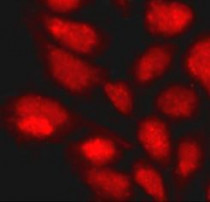ARG55782
anti-SH2D1A / SAP antibody
anti-SH2D1A / SAP antibody for ICC/IF,Western blot and Human,Mouse
Overview
| Product Description | Rabbit Polyclonal antibody recognizes SH2D1A |
|---|---|
| Tested Reactivity | Hu, Ms |
| Tested Application | ICC/IF, WB |
| Host | Rabbit |
| Clonality | Polyclonal |
| Isotype | IgG |
| Target Name | SH2D1A / SAP |
| Antigen Species | Human |
| Immunogen | Recombinant protein of Human SH2D1A |
| Conjugation | Un-conjugated |
| Alternate Names | SLAM-associated protein; T-cell signal transduction molecule SAP; IMD5; EBVS; Duncan disease SH2-protein; Signaling lymphocytic activation molecule-associated protein; SAP/SH2D1A; DSHP; SH2 domain-containing protein 1A; MTCP1; XLPD; LYP; XLPD1; SAP; XLP |
Application Instructions
| Predict Reactivity Note | Mouse, Rat | ||||||
|---|---|---|---|---|---|---|---|
| Application Suggestion |
|
||||||
| Application Note | * The dilutions indicate recommended starting dilutions and the optimal dilutions or concentrations should be determined by the scientist. | ||||||
| Positive Control | Jurkat | ||||||
| Observed Size | 17 kDa |
Properties
| Form | Liquid |
|---|---|
| Purification | Affinity purification with immunogen. |
| Buffer | PBS (pH 7.3), 0.02% Sodium azide and 50% Glycerol. |
| Preservative | 0.02% Sodium azide |
| Stabilizer | 50% Glycerol |
| Storage Instruction | For continuous use, store undiluted antibody at 2-8°C for up to a week. For long-term storage, aliquot and store at -20°C. Storage in frost free freezers is not recommended. Avoid repeated freeze/thaw cycles. Suggest spin the vial prior to opening. The antibody solution should be gently mixed before use. |
| Note | For laboratory research only, not for drug, diagnostic or other use. |
Bioinformation
| Database Links | |
|---|---|
| Gene Symbol | SH2D1A |
| Gene Full Name | SH2 domain containing 1A |
| Background | This gene encodes a protein that plays a major role in the bidirectional stimulation of T and B cells. This protein contains an SH2 domain and a short tail. It associates with the signaling lymphocyte-activation molecule, thereby acting as an inhibitor of this transmembrane protein by blocking the recruitment of the SH2-domain-containing signal-transduction molecule SHP-2 to its docking site. This protein can also bind to other related surface molecules that are expressed on activated T, B and NK cells, thereby modifying signal transduction pathways in these cells. Mutations in this gene cause lymphoproliferative syndrome X-linked type 1 or Duncan disease, a rare immunodeficiency characterized by extreme susceptibility to infection with Epstein-Barr virus, with symptoms including severe mononucleosis and malignant lymphoma. Multiple transcript variants encoding different isoforms have been found for this gene. [provided by RefSeq, Jul 2008] |
| Function | Inhibitor of the SLAM self-association. Acts by blocking recruitment of the SH2-domain-containing signal-transduction molecule SHP-2 to a docking site in the SLAM cytoplasmic region. Mediates interaction between FYN and SLAMF1. May also regulate the activity of the neurotrophin receptors NTRK1, NTRK2 and NTRK3. [UniProt] |
| Calculated MW | 14 kDa |
Images (2) Click the Picture to Zoom In







